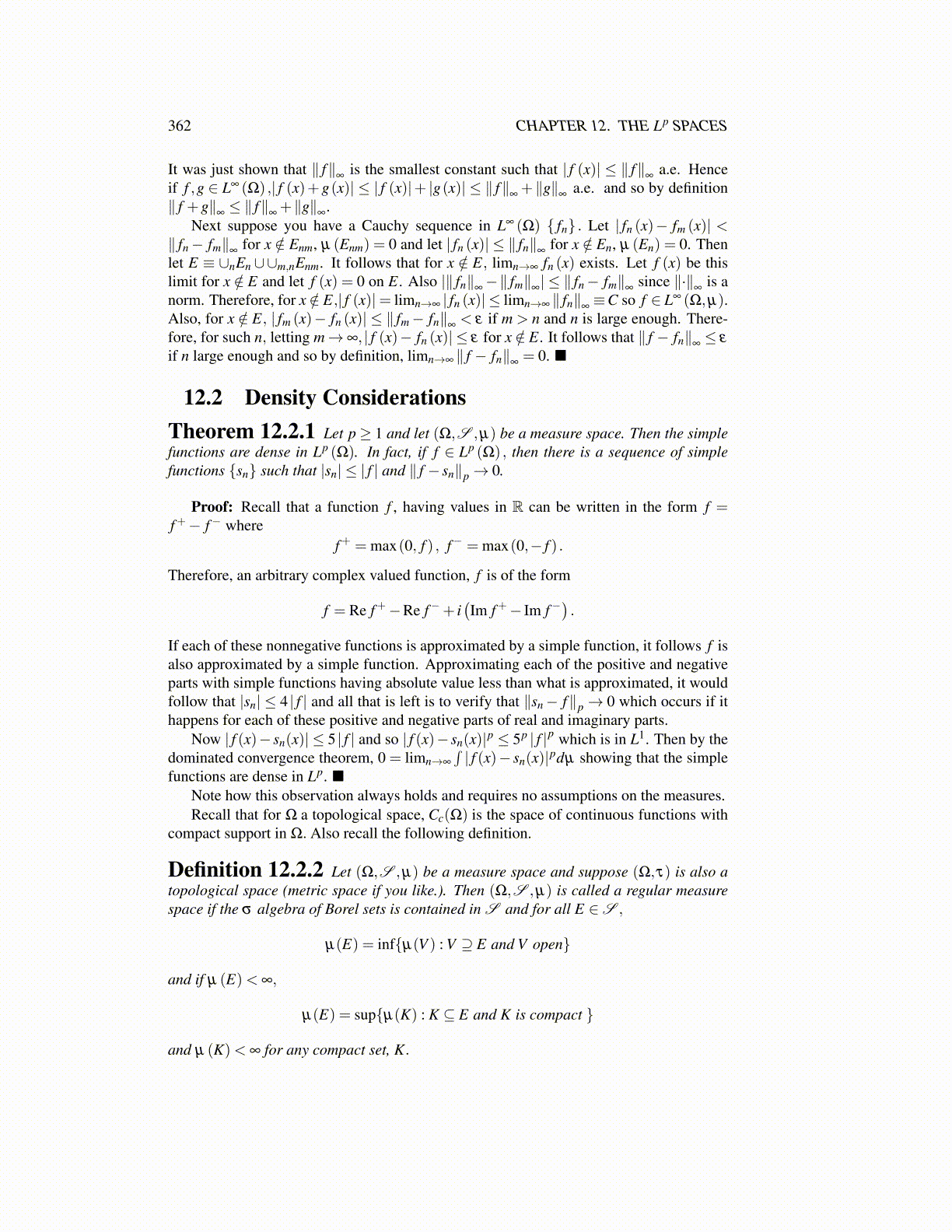
362 CHAPTER 12. THE Lp SPACES
It was just shown that ∥ f∥∞
is the smallest constant such that | f (x)| ≤ ∥ f∥∞
a.e. Henceif f ,g ∈ L∞ (Ω) ,| f (x)+g(x)| ≤ | f (x)|+ |g(x)| ≤ ∥ f∥
∞+ ∥g∥
∞a.e. and so by definition
∥ f +g∥∞≤ ∥ f∥
∞+∥g∥
∞.
Next suppose you have a Cauchy sequence in L∞ (Ω) { fn} . Let | fn (x)− fm (x)| <∥ fn− fm∥∞
for x /∈ Enm, µ (Enm) = 0 and let | fn (x)| ≤ ∥ fn∥∞for x /∈ En, µ (En) = 0. Then
let E ≡ ∪nEn ∪∪m,nEnm. It follows that for x /∈ E, limn→∞ fn (x) exists. Let f (x) be thislimit for x /∈ E and let f (x) = 0 on E. Also |∥ fn∥∞
−∥ fm∥∞| ≤ ∥ fn− fm∥∞
since ∥·∥∞
is anorm. Therefore, for x /∈ E,| f (x)|= limn→∞ | fn (x)| ≤ limn→∞ ∥ fn∥∞
≡C so f ∈ L∞ (Ω,µ).Also, for x /∈ E, | fm (x)− fn (x)| ≤ ∥ fm− fn∥∞
< ε if m > n and n is large enough. There-fore, for such n, letting m→∞, | f (x)− fn (x)| ≤ ε for x /∈ E. It follows that ∥ f − fn∥∞
≤ ε
if n large enough and so by definition, limn→∞ ∥ f − fn∥∞= 0. ■
12.2 Density ConsiderationsTheorem 12.2.1 Let p≥ 1 and let (Ω,S ,µ) be a measure space. Then the simplefunctions are dense in Lp (Ω). In fact, if f ∈ Lp (Ω) , then there is a sequence of simplefunctions {sn} such that |sn| ≤ | f | and ∥ f − sn∥p→ 0.
Proof: Recall that a function f , having values in R can be written in the form f =f+− f− where
f+ = max(0, f ) , f− = max(0,− f ) .
Therefore, an arbitrary complex valued function, f is of the form
f = Re f+−Re f−+ i(Im f+− Im f−
).
If each of these nonnegative functions is approximated by a simple function, it follows f isalso approximated by a simple function. Approximating each of the positive and negativeparts with simple functions having absolute value less than what is approximated, it wouldfollow that |sn| ≤ 4 | f | and all that is left is to verify that ∥sn− f∥p→ 0 which occurs if ithappens for each of these positive and negative parts of real and imaginary parts.
Now | f (x)− sn(x)| ≤ 5 | f | and so | f (x)− sn(x)|p ≤ 5p | f |p which is in L1. Then by thedominated convergence theorem, 0 = limn→∞
∫| f (x)− sn(x)|pdµ showing that the simple
functions are dense in Lp. ■Note how this observation always holds and requires no assumptions on the measures.Recall that for Ω a topological space, Cc(Ω) is the space of continuous functions with
compact support in Ω. Also recall the following definition.
Definition 12.2.2 Let (Ω,S ,µ) be a measure space and suppose (Ω,τ) is also atopological space (metric space if you like.). Then (Ω,S ,µ) is called a regular measurespace if the σ algebra of Borel sets is contained in S and for all E ∈S ,
µ(E) = inf{µ(V ) : V ⊇ E and V open}
and if µ (E)< ∞,
µ(E) = sup{µ(K) : K ⊆ E and K is compact }
and µ (K)< ∞ for any compact set, K.